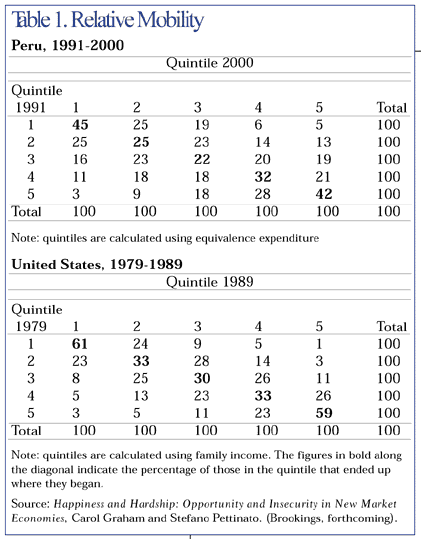Removing market distortions is a first step toward creating new opportunities for the poor to move out of poverty. It is not, however, a sufficient one. While reforms have provided new opportunities for many poor people to move up the income ladder, reforms have also created new vulnerabilities for other groups —particularly those that were previously middle-class and had secure public sector jobs—and many of them have fallen to at or near poverty levels. Aggregate inequality measures like the Gini coefficient, which are static snapshots of countries' income distributions, mask a great deal of movement up and down the income ladder. If one compares relative mobility trends in a country like Peru, for example, with those in the United States over a 10-year period, one sees many more people moving up — and down — several income quintiles in Peru. [Table 1]

Reforms and Inequality
Advertisement
The record on reforms and inequality as measured by the Gini coefficient is mixed. Inequality has gone down in some countries and increased slightly in others. Part of the inequality has been driven by increasing disparities in rewards to skilled and educated labor versus their unskilled counterparts. Contrary to what the theory predicted—that trade would reward unskilled labor, which is in much greater supply in Latin America—the rewards from the opening to trade have been to skilled labor, which is scarce.
Over the last several years, returns to higher education in Latin America have risen dramatically relative to returns to secondary and primary education. Although in the 1960s and 1970s a secondary education was sufficient to attain a stable job and a "middle-class"—and indeed fairly privileged—standard of living, by the 1990s it guaranteed neither a well-paying job nor protection from falling into poverty. Many of those who completed secondary schooling (rather than higher levels) were public sector workers; in 1990, there were far fewer public sector jobs, and they were also less desirable.
An important and related trend is top-driven inequality: high levels of wealth at the top of the distribution compared to the rest of society, where income is not as unequally distributed. In Latin America, where inequality levels are especially top-heavy, the trend is driven primarily by gaps between the top decile and the rest of the distribution, including the ninth decile. According to Miguel Szekely and Marianne Hilgert of the Inter-American Development Bank, although in many Latin American countries the richest 10 percent earn three times what the next richest 10 percent earn, this difference does not exceed 1.6 in the United States, the United Kingdom, and Canada.
Top-driven inequality is driven in part by the rising wage premium to educated workers. It may also be driven by a possible increase in wealth at the top, as more open capital markets enhance opportunities for high returns. In addition, taxes on mobile capital (to the extent they were effective) are probably declining, while in developing countries, shallow financial sectors and underdeveloped capital markets may be limiting investment opportunities for small savers and borrowers. Finally, it is difficult to measure top-driven inequality. As noted by Vito Tanzi and Howell Zee of the International Monetary Fund, labor income is poorly measured at the top, and there is substantial underreporting in less developed countries, often through legal exemptions. Second, in all countries, income from wealth is undercounted.
The uneven manner in which people have shared in the benefits of globalization and market reforms, as well as the new insecurities that have accompanied new opportunities, are surely part of the reason why public opinion is so mixed. Those that perceive themselves as losers are not necessarily the poor, but rather those in the middle of the income distribution who are vulnerable to falling into poverty. At the same time, those in the middle are acutely aware of the extent to which gains from the market process have been very high for those at the top of the income distribution.
Frustrated Achievers in New Market Economies
Advertisement
Most of the literature on subjective well-being finds that after a certain level of absolute income, individuals' satisfaction or happiness is determined by relative rather than absolute income levels. These findings hold across countries, regions, and development levels, other than for the very poorest countries. My research with Pettinato generally supports these findings, with very clear implications for the debate on public support for globalization.
In repeated household surveys in Peru during a 10-year period of market reforms, we found that of the respondents with the most upward income mobility (gains of 30 percent or more), 44 percent reported that they were worse off. Household surveys conducted in Russia during a period of market change yield more negative results, with 71 percent of upwardly mobile respondents reporting that they were worse off. (See Figures 2A and 2B)
What explains the frustrations and misperceptions of our achievers? We found that in Peru they had average income levels, but were more urban and older than non-frustrated upwardly mobile respondents. In Russia, we found that the frustrated respondents had slightly lower than average income levels and had also experienced more income volatility (as measured by the coefficient of variation) than had the upwardly mobile respondents who were not frustrated. For the most part, then, these respondents were NOT the poorest in the sample, but rather tended towards the middle of the distribution. In Peru, while poorer respondents were much more likely to answer that their economic condition was the same as it had been before, those in the middle were much more likely to say that it was worse.